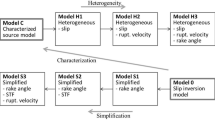Abstract
We propose a mathematical representation to qualitatively describe the spatio-temporal slip evolution during earthquake rupture in an efficient and easy-to-use manner for numerical simulations of strong ground motion. It is based on three basis functions and associated expansion coefficients. It is an extension of the approach of Ide and Takeo, (J Geophys Res, 102:27379–27391, 1997). We compare our approach and theirs using simple kinematic source models to illustrate differences between the two approaches, and show that our approach more accurately represents the spatio-temporal slip evolution. We also propose a technique based on our representation for extracting a spatio-temporal slip velocity function from a kinematic source model obtained by the conventional source inversion. We then demonstrate the feasibility of our procedure with application to an inverted source model of the 26 March 1997 Northwestern Kagoshima, Japan, earthquake (M W6.1). In the simulations for actual earthquakes, source models obtained from kinematic source inversions are commonly employed. Our scheme could be used as an interpolation method of slip time functions from relatively coarse finite-source models obtained by conventional kinematic source inversions.
Similar content being viewed by others
References
Fujii Y (2004) Source process of the 1997 Northwestern Kagoshima earthquakes inferred from waveform inversion with high resolution using a three-dimensionally heterogeneous structure model, PhD thesis, Kyushu University
Graves RW, Wald DJ (2004) Observed and simulated ground motions in the San Bernardino basin region for the Hector Mine, California earthquake. Bull Seism Soc Am 94:131–146
Hartzell SH, Heaton TH (1983) Inversion of strong ground motion and teleseismic waveform data for the fault rupture history of the 1979 Imperial Valley, California, earthquake. Bull Seism Soc Am 73:1553–1583
Ide S, Takeo M (1997) Determination of constitutive relations of fault slip based on seismic wave analysis. J Geophys Res 102:27379–27391
Kostrov BV (1964) Selfsimilar problems of propagation of shear cracks, PMM. J Appl Math Mech 28:889–898
Lawson CL, Hanson RJ (1974) Solving Least Squares Problems. Prentice-Hall, Englewood Cliffs, N.J
Olsen KB, Akinci A, Rovelli A, Marra F, Malagnini L (2006) 3D ground-motion estimation in Rome, Italy. Bull Seism Soc Am 96:133–146
Olson AH, Apsel RJ (1982) Finite faults and inverse theory with applications to the 1979 Imperial Valley earthquake. Bull Seism Soc Am 72:1969–2001
Pitarka A, Irikura K, Iwata T, Sekiguchi H (1998) Three-dimensional simulation of the near-fault ground motion for the 1995 Hyogo-Ken Nanbu (Kobe), Japan earthquake. Bull Seism Soc Am 88:428–440
Sekiguchi H, Irikura K, Iwata T (2002) Source inversion for estimating the continuous slip distribution on a fault – introduction of Green’s functions convolved with correction function to give moving dislocation effects in subfaults. Geophys J Int 150:377–391
Tinti E, Spudich P, Cocco M (2005) Earthquake fracture energy inferred from kinematic rupture models on extended faults. J Geophys Res 110 (B12303), DOI 10.1029/2005JB00644
Toda S, Stein R (2003) Toggling of seismicity by the 1997 Kagoshima earthquake couplet: a demonstration of time-dependent stress transfer. J Geophys Res 108(B12):2567 DOI 10.1029/2003JB002527
Wald DJ (1996) Slip history of the 1995 Kobe, Japan earthquake determined from strong motion, teleseismic, and geodetic data. J Phys Earth 44:489–503
Wald DJ, Heaton TH (1994) Spatial and temporal distribution of slip for the 1992 Landers, California, earthquake. Bull seism Soc Am 84:668–691
Wald DJ, Heaton TH, Hudnut KW (1996) The slip history of the 1994 Northridge, California, earthquake determined from strong-motion, teleseismic, GPS, and leveling data. Bull seism Soc Am 86:S49–S70
Wessel P, Smith WHF (1998) New, improved version of the generic mapping tools released.. EOS Transaction American Geophysical Union 79:579
Author information
Authors and Affiliations
Corresponding author
Rights and permissions
About this article
Cite this article
Takenaka, H., Fujii, Y. A compact representation of spatio-temporal slip distribution on a rupturing fault. J Seismol 12, 281–293 (2008). https://doi.org/10.1007/s10950-007-9087-6
Received:
Accepted:
Published:
Issue Date:
DOI: https://doi.org/10.1007/s10950-007-9087-6




